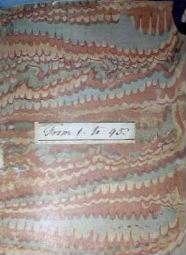[1] Roger Fiske and Gerald Griffith, “George Berg,” Grove Music Online at www.grovemusic.com (accessed 20 February 2006).
[2] George Berg, Experiments in Chemistry 1759-1774 (hereafter Experiments). Unpublished manuscript, privately held.
[3] Berg, Experiments, Notebook 2 after Experiment 107.
[4] Berg, Experiments, Notebook 1, Experiments 51 & 52. The latter is dated 10 April [1761].
[5] St. Mary at Hill Church Warden Records 1737-1800, Guildhall Library, Ms. 1239/4; Fiske and Griffith, Grove Music Online; Records of Foreign Churches: German Lutheran Church, Savoy, Strand (Lutheran): Deaths & Burials, National Archives, London, RG/4/4628.
[6] A Catalogue of the Valuable and Scarce Collection of Music, by the Most Eminent Composers, Fine Ton’d Instruments, Books &c, Late the Property of Mr. George Berg, dec., Christie’s, 8–9 March 1776 (London, 1776) [auction catalogue].
[7] Among the books Berg owned or consulted are Peter Shaw, Chemical Lectures, Publickly Read at London, in the Years 1731, and 1732; and at Scarborough, in 1733; For the Improvement of Arts, Trades, and Natural Philosophy (London, [1734]); James Millar, A New Course of Chymistry (London, 1754); Temple Henry Croker. The Complete Dictionary of Arts and Sciences . . . . (London, 1764–1766); Grosman, A Treatise for the Service of Chemistry in General . . . . (London, 1766); John Russell, Elements of Painting with Crayons (London, 1772); Godfrey Smith, Laboratory, or School of the Arts, 2 vols. (London, 1736); Axel Cronstedt, Essay Toward a System of Mineralogy, trans. Emanuel Mendes da Costa (London, 1772).
[8] Robert Dingley, “Some Observations Upon Gems or Precious Stones; More Particularly Such as the Ancients Used to Engrave Upon,” Philosophical Transactions of the Royal Society of London 44 (1746–47): 502–6.
[9] Harry J. Powell, Glassmaking in England (Cambridge, 1923), 150; Eric Benton, “The London Enamellers” Transactions of the English Ceramic Circle 8 (1972): 137–66.
[10] Berg, Experiments, verso of paper inserted into Notebook 2 after Experiment 106 (6 July 1765). An example of his use of this information is found in Notebook 3, Experiment 174 (27 April 1767).
[11] Edward Hussey Delaval, A Letter to the Right Honourable the Earl of Morton, President of the Royal Society. Containing Experiments and Observations on the Agreement between the Specific Gravities of the Several Metals, and Their Colours When United to Glass, ... Read at the Royal Society Jan. 24, 1765 (London: n.p., 1765).
[12] Wolf Mankowitz, The Portland Vase and the Wedgwood Copies [London, 1952]; Whitehouse, David B., ed., “The Portland Vase,” special issue of Journal of Glass Studies 32 (1990).
[13] Royal Society of Arts, Minutes of Committees 1771–1772 through 1774–1775 PR/GE/112/12/13–16.
[14] Minutes of the Committee of Polite Arts, 26 November 1774, Royal Society of Arts, Minutes of Committees 1774–1775 PR/GE/112/12/16.
[15] Minutes of the Chemistry Committee, 30 January 1773, Royal Society of Arts, Minutes of Committees 1772–1773 PR/GE/112/12/14.
[16] Berg, Experiments, Experiment 489, 9 October 1773.
[17] Johann Heinrich Pott, Lithogeognosia (Berlin, 1738); Johannes Kunckel’s Ars Vitraria ExperimentalisSol Sine Veste were appended to several translations of Antonio Neri’s L’Arte Vetreria and Orschall’s (originally published in Venice in 1612). Christopher Merrit translated this work into English in the late seventeenth century.
[18] For biographical information about Samuel More, see G. C. Mercer, “Mr. More of the Adelphi: Notes on the Life and Work of Samuel More, Secretary of the Society, 1770-1799,” The Virtuoso Tribe of Arts and Sciences: Studies in the 18th-Century Work and Membership of the London Society of Arts, D.G.C. Allan and John L. Abbott, eds. (Athens, GA, 1992): 307–35.
[19] Berg, Experiments, Notebook 1, Experiments 12 and 13, 28 and 29 [December 1759].
[20] Berg, Experiments, recto of paper inserted into Notebook 2 after Experiment 106 (6 July 1765).
[21] Will of George Berg, proved 4 May 1775, Records of the Prerogative Court of Canterbury, National Archives, London, PROB 11/1007; will of Elizabeth Berg, proved 22 May 1784, Records of the Prerogative Court of Canterbury, National Archives, London, PROB 11/1116.
[22] Berg, Experiment Book, Notebook 5, n.p. [2 v.], [ca. September 1770].

